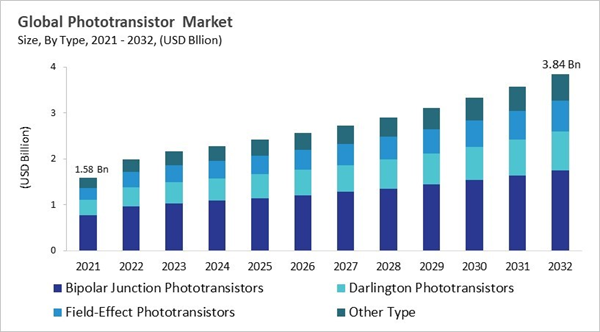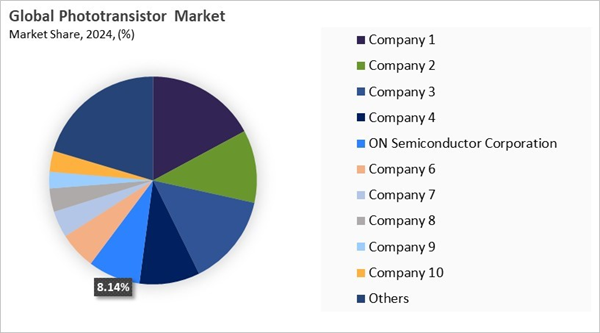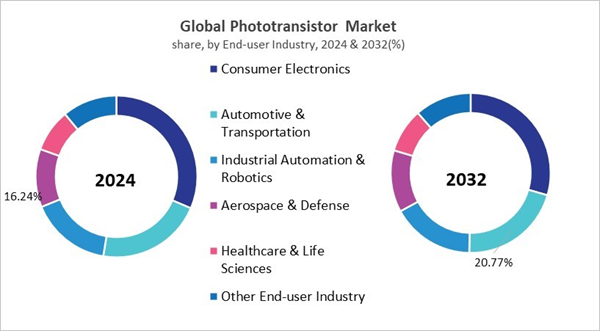Key Highlights:
- The North America Phototransistor market dominated the Global Market in 2024, accounting for a 37.90% revenue share in 2024.
- The US Phototransistor market is expected to continue its dominance in North America region thereby reaching a market size of 73 million by 2032.
- Among the various Wavelength Spectrum segments, Visible segment dominated the global market contributing a revenue share of 47.44% in 2024.
- In terms of material segmentation, the Silicon segment is projected to dominate the global market with the projected revenue share of 61.49% in 2032.
- Consumer Electronics led the end use segments in 2024, capturing a 31.44% revenue share and is projected to continue its dominance during projected period.
The phototransistors have recently been developed as silicon-dominated components that are crucial for consumer and industrial electronics. The usage of phototransistors has expanded in products such as TVs, automation systems, and cameras, with the improving performance of photodarlington variants. With the globalized production, manufacturing shifted to East India for consumer markets; however, Japanese and Western providers focused on high-reliability applications in aerospace, industrial, and automotive sectors. Phototransistors have become central to portable electronics, safety systems, and smart sensors, thereby supporting the expansion of automotive electronics, energy-efficient technologies, and IoT.
The phototransistors market is estimated to grow steadily, driven by the expansion of spectral sensitivity, diversification of applications, and miniaturization of integration. Moreover, the providers are exploring advanced materials such as graphene, wide-bandgap semiconductors, and perovskites, in order to extend responsiveness, while innovations in packaging allow greater selectivity and resilience. IoT systems, industrial automation, and automotive are raising significant demand, with the rising regulations on energy efficiency further encouraging adoption. Key market players such as Vishay, Rohn, Lite-ON, and Everlight are focused on balancing R&D, compliance with global standards, cost-optimization, and diversification across industries.
Driving and Restraining Factors
Drivers
- Rising Demand for Consumer Electronics
- Expansion of Automotive Electronics and ADAS
- Industrial Automation and Smart Infrastructure
- Healthcare and Medical Devices
Restraints
- Sensitivity to Ambient Light and Noise Interference
- Limited Response Speed and Bandwidth
- Competition from Advanced Alternatives and Integration Trends
Opportunities
- Expansion in Smart and Connected Consumer Electronics
- Advancements in Automotive Safety and Autonomous Driving
- Expansion into Healthcare and Biophotonics Applications
Challenges
- Rising Competition from Emerging and Alternative Sensing Technologies
- Supply Chain Vulnerabilities and Raw Material Dependencies
- Performance Limitations in Emerging High-Tech Applications
COVID-19 Impact Analysis
The COVID-19 pandemic significantly disrupted the global phototransistor market, causing delays in manufacturing due to supply chain interruptions, raw material shortages, and workforce limitations. Lockdowns and export restrictions made things even harder, and demand fell as important end-user industries like consumer electronics, automotive, and industrial automation slowed down. Reduced consumer spending, halted automotive production, and delayed industrial projects curtailed adoption of phototransistor-based technologies. Companies had to cut back on research and development and new ideas because of money problems, especially small and medium-sized businesses. Trade shows and other in-person marketing events were canceled or moved online, which made it harder for people to see the products. During the crisis, market growth came to a halt because strategic decisions like expansions and new product launches were put on hold. Thus, the COVID-19 pandemic had a negative impact on the market.Market Share Analysis
The leading players in the market are competing with diverse innovative offerings to remain competitive in the market. The above illustration shows the percentage of revenue shared by some of the leading companies in the market. The leading players of the market are adopting various strategies to cater demand coming from the different industries. The key developmental strategies in the market are Acquisitions, and Partnerships & Collaborations.
End Use Outlook
On the basis of end-user industry, the phototransistor market is classified into consumer electronics, automotive & transportation, industrial automation & robotics, aerospace & defense, healthcare & life sciences, and others. The automotive & transportation segment recorded 21% revenue share in the market in 2024. Particularly in applications involving vehicle safety systems, lighting controls, display systems, and advanced driver-assistance systems (ADAS). As modern vehicles incorporate more electronics and smart functionalities, phototransistors play an essential role in enhancing efficiency, responsiveness, and safety. Their robustness and precision in detecting and responding to light signals have positioned them as valuable components across various automotive innovations.Wavelength Spectrum Outlook
Based on wavelength spectrum, the phototransistor market is characterized into visible, near-infrared (NIR), ultraviolet (UV), and others. The near-infrared (NIR) segment attained 28% revenue share in the market in 2024. This is supported by its significant role in communication technologies, medical diagnostics, and sensing applications. NIR phototransistors are widely utilized in remote control systems, optical communication networks, and non-invasive medical devices due to their ability to operate effectively in low-light conditions. The growing use of NIR technology in industrial automation and safety systems has also created new opportunities for this segment, reinforcing its position within the market landscape.Regional Outlook
Region-wise, the phototransistor market is analyzed across North America, Europe, Asia Pacific, and LAMEA. The North America segment recorded 38% revenue share in the market in 2024. The phototransistors have recently been developed as silicon-dominated components that are crucial for consumer and industrial electronics. The usage of phototransistors has expanded in products such as TVs, automation systems, and cameras, with the improving performance of photodarlington variants. With the globalized production, manufacturing shifted to East India for consumer markets; however, Japanese and Western providers focused on high-reliability applications in aerospace, industrial, and automotive sectors. Phototransistors have become central to portable electronics, safety systems, and smart sensors, thereby supporting the expansion of automotive electronics, energy-efficient technologies, and IoT.The phototransistors market is estimated to grow steadily, driven by the expansion of spectral sensitivity, diversification of applications, and miniaturization of integration. Moreover, the providers are exploring advanced materials such as graphene, wide-bandgap semiconductors, and perovskites, to extend responsiveness, while innovations in packaging allow greater selectivity and resilience. IoT systems, industrial automation, and automotive are raising significant demand, with the rising regulations on energy efficiency further encouraging adoption. Key market players such as Vishay, Rohn, Lite-ON, and Everlight are focused on balancing R&D, compliance with global standards, cost-optimization, and diversification across industries.
List of Key Companies Profiled
- Hamamatsu Photonics K.K.
- Vishay Intertechnology, Inc.
- ams-OSRAM AG
- Rohm Semiconductors Co., Ltd.
- ON Semiconductor Corporation
- Excelitas Technologies Corp.
- Sharp Corporation
- Honeywell International, Inc.
- TT Electronics PLC
- Broadcom, Inc.
Market Report Segmentation
By Type
- Bipolar Junction Phototransistors
- Darlington Phototransistors
- Field-Effect Phototransistors
- Other Type
By End-user Industry
- Consumer Electronics
- Automotive & Transportation
- Industrial Automation & Robotics
- Aerospace & Defense
- Healthcare & Life Sciences
- Other End-user Industry
By Material
- Silicon
- InGaAs / III-V
- Germanium
- Other Material
By Wavelength Spectrum
- Visible
- Near-Infrared (NIR)
- Ultraviolet (UV)
- Other Wavelength Spectrum
By Geography
- North America
- US
- Canada
- Mexico
- Rest of North America
- Europe
- Germany
- UK
- France
- Russia
- Spain
- Italy
- Rest of Europe
- Asia Pacific
- China
- Japan
- India
- South Korea
- Singapore
- Malaysia
- Rest of Asia Pacific
- LAMEA
- Brazil
- Argentina
- UAE
- Saudi Arabia
- South Africa
- Nigeria
- Rest of LAMEA
Table of Contents
Companies Mentioned
- Hamamatsu Photonics K.K.
- Vishay Intertechnology, Inc.
- ams-OSRAM AG
- Rohm Semiconductors Co., Ltd.
- ON Semiconductor Corporation
- Excelitas Technologies Corp.
- Sharp Corporation
- Honeywell International, Inc.
- TT Electronics PLC
- Broadcom, Inc.











